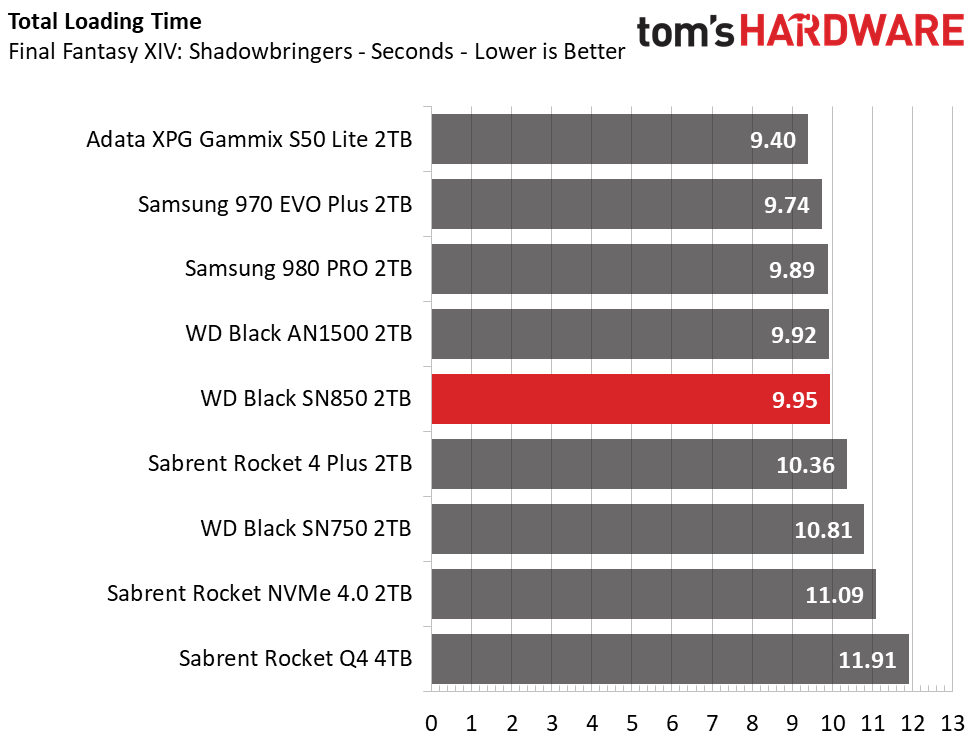Why you can trust Tom's Hardware
Comparison Products
We put the 2TB WD Black SN850 against the best PCIe 4.0 SSDs on the market, along with a few PCIe 3.0 options to put things into perspective. We threw in WD’s mainstream Black SN750 and the Black AN1500, an SSD that’s a RAID 0 beast. We also included the 980 Pro and 970 EVO Plus from Samsung, along with a few Sabrent Rocket SSDs, too - the Q4, NVMe 4.0, and the new 4 Plus. We also threw in Adata’s Gammix S50 Lite, a low-cost but very responsive entry-level PCIe 4.0 M.2 SSD.
Game Scene Loading - Final Fantasy XIV
Final Fantasy XIV Shadowbringers is a free real-world game benchmark that easily and accurately compares game load times without the inaccuracy of using a stopwatch.
Outperforming the SN850 by roughly half a second, Adata’s XPG Gammix S50 Lite proves that you don’t necessarily need the fastest SSD available to enjoy fast game load times. Still, while the 2TB Black SN850 may have lagged the XPG with its fifth-place ranking, it’s a very responsive SSD that’s roughly the same as Samsung’s best.
Transfer Rates – DiskBench
We use the DiskBench storage benchmarking tool to test file transfer performance with a custom dataset. We copy a 50GB dataset, including 31,227 files of various types, like pictures, PDFs, and videos, to a new folder and then follow-up with a reading test of a newly-written 6.5GB zip file.

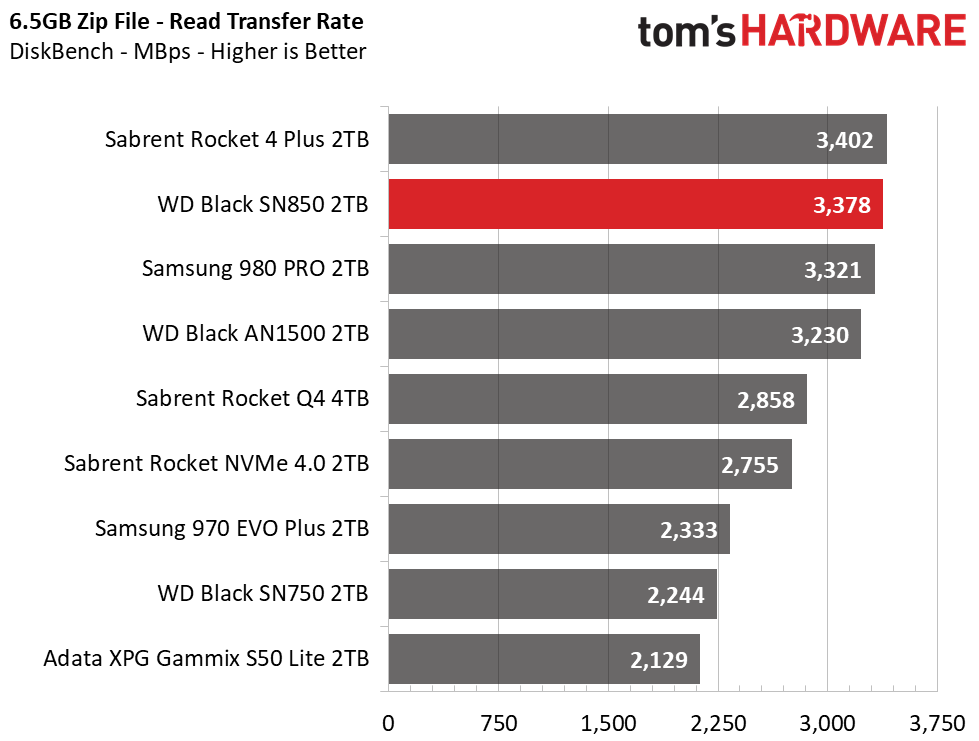
WD’s Black SN850 scored solid results during its DiskBench runs, taking second place behind the Samsung 980 Pro in the 50GB copy test. The SN850 also placed second behind the Sabrent Rocket 4 Plus when we read back the files, proving it is a well-balanced drive that’s one of the fastest at moving around large files.
Trace Testing – PCMark 10 Storage Test
PCMark 10 is a trace-based benchmark that uses a wide-ranging set of real-world traces from popular applications and everyday tasks to measure the performance of storage devices. The quick benchmark is more relatable to those who use their PCs for leisure or basic office work, while the full benchmark relates more to power users.
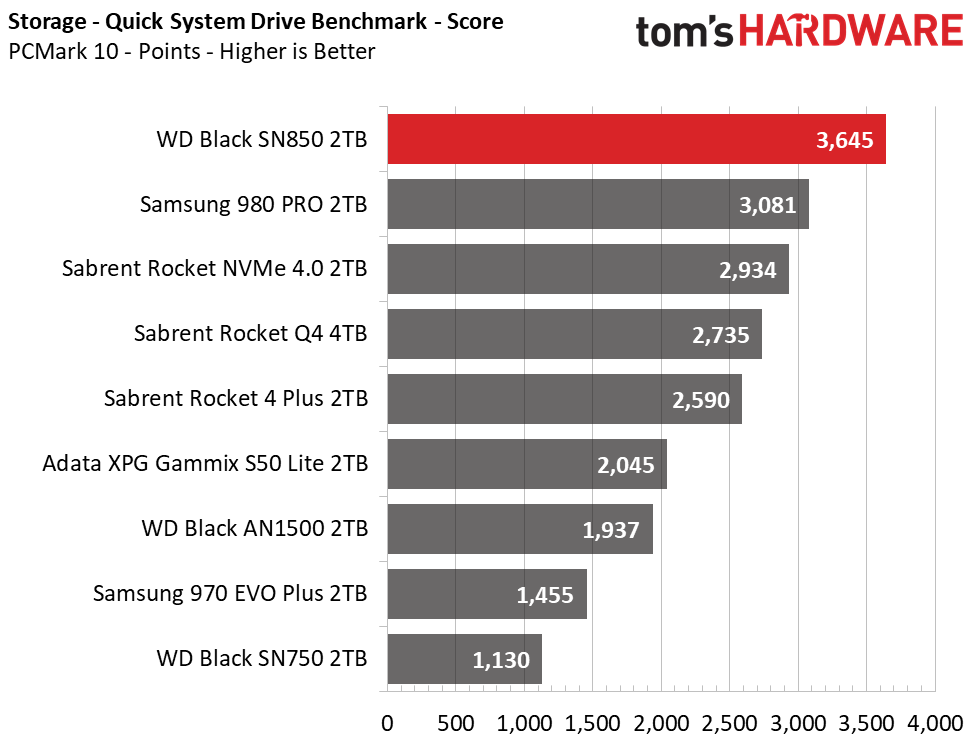
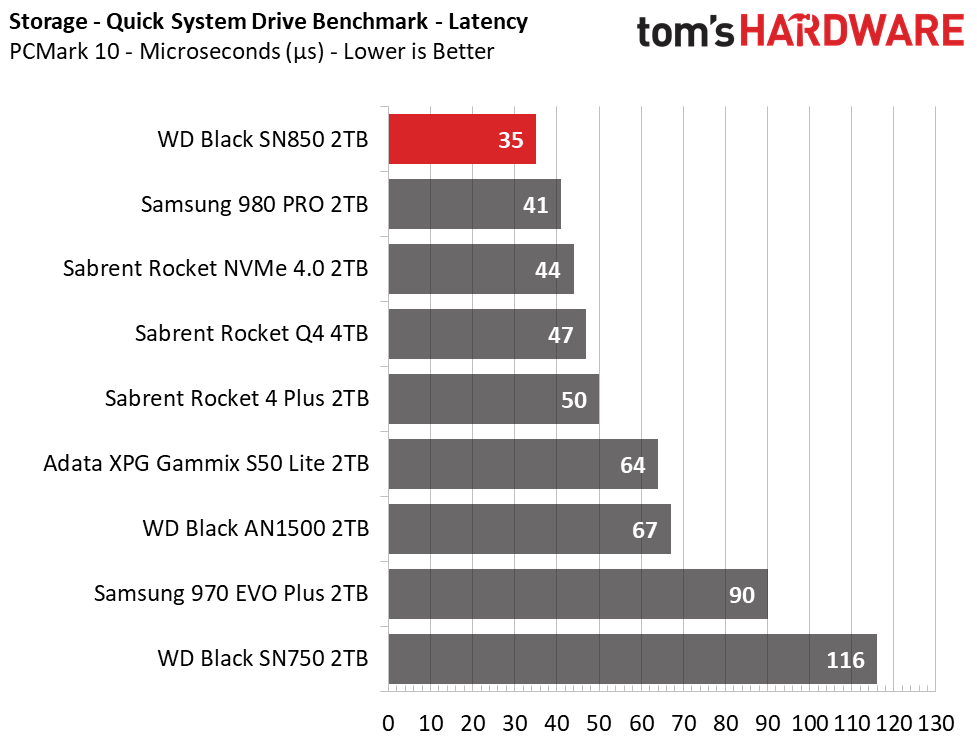
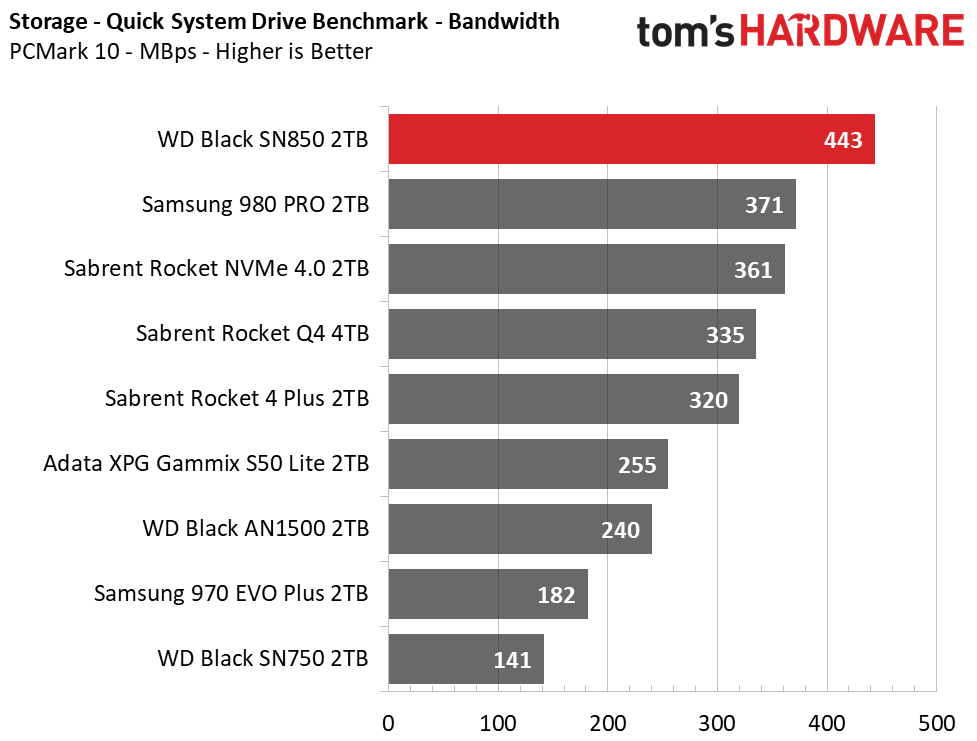
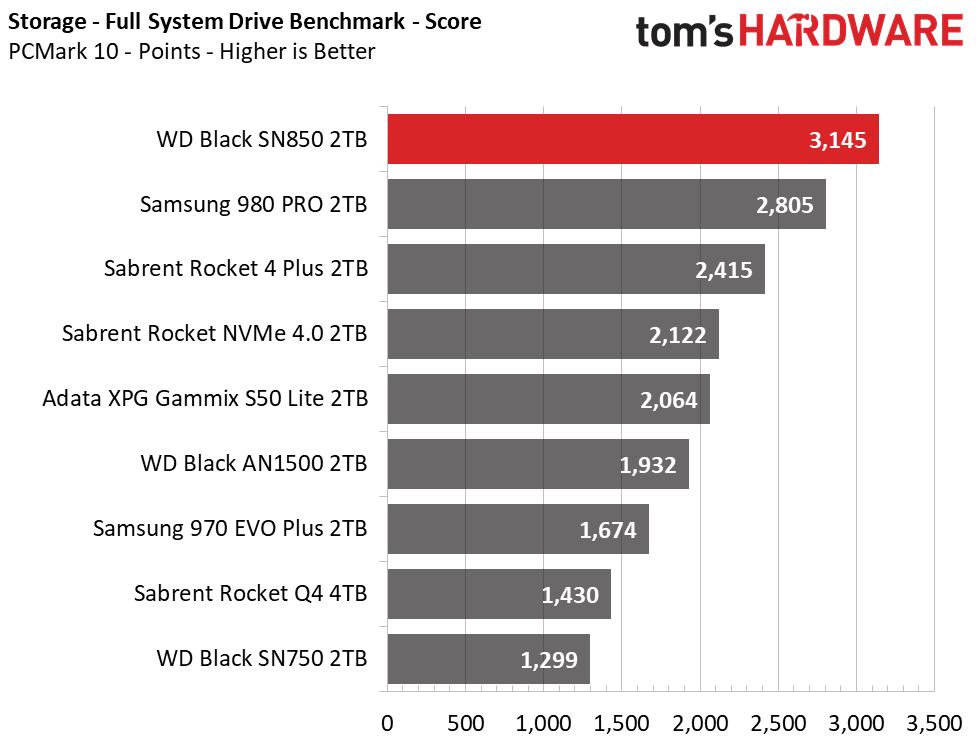
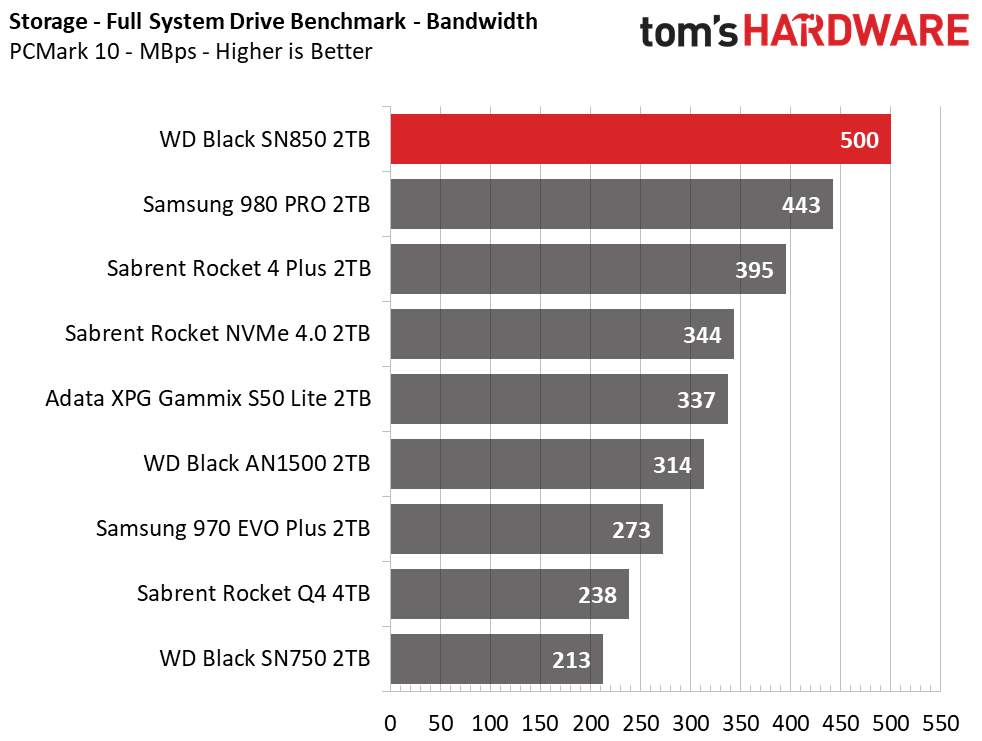

There's almost no better drive on the market at servicing application requests in a fast and responsive manner. The SN850 outperformed every other SSD in both PCMark 10’s Quick System Drive benchmark and the much heavier Full System Drive benchmark. Even the Samsung 980 Pro can’t match WD’s Black SN850 in PCMark. This impressive performance stems from WD’s optimized nCache 4.0, which we’ll detail shortly.
Get Tom's Hardware's best news and in-depth reviews, straight to your inbox.
Synthetic Testing - ATTO / iometer
iometer is an advanced and highly configurable storage benchmarking tool while ATTO is a simple and free application that SSD vendors commonly use to assign sequential performance specifications to their products. Both of these tools give us insight into how the device handles different file sizes.
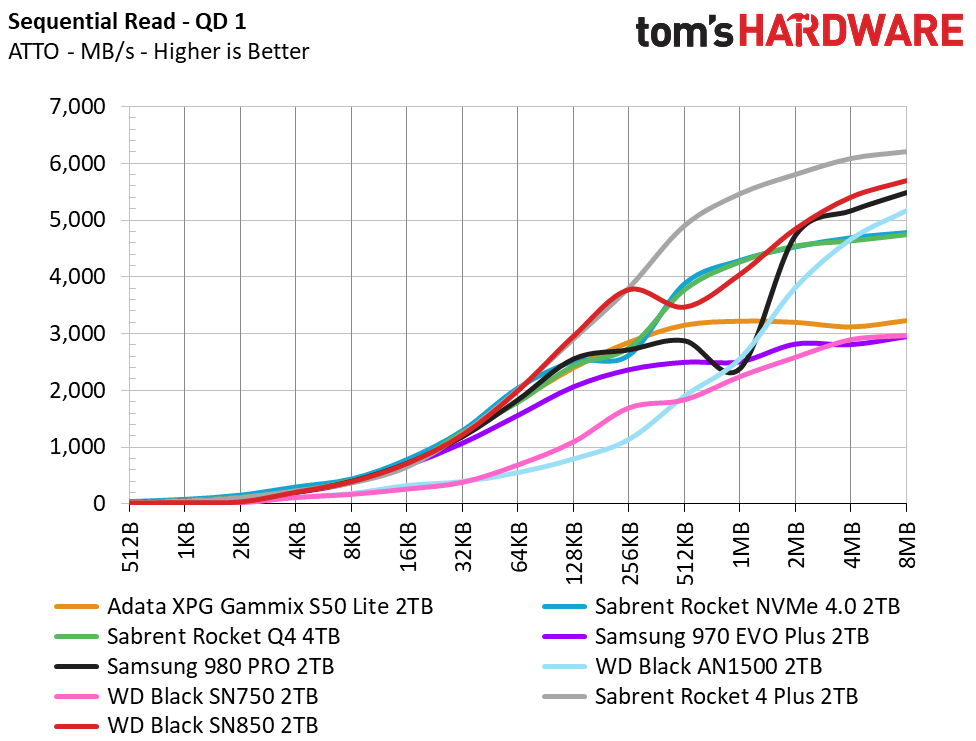

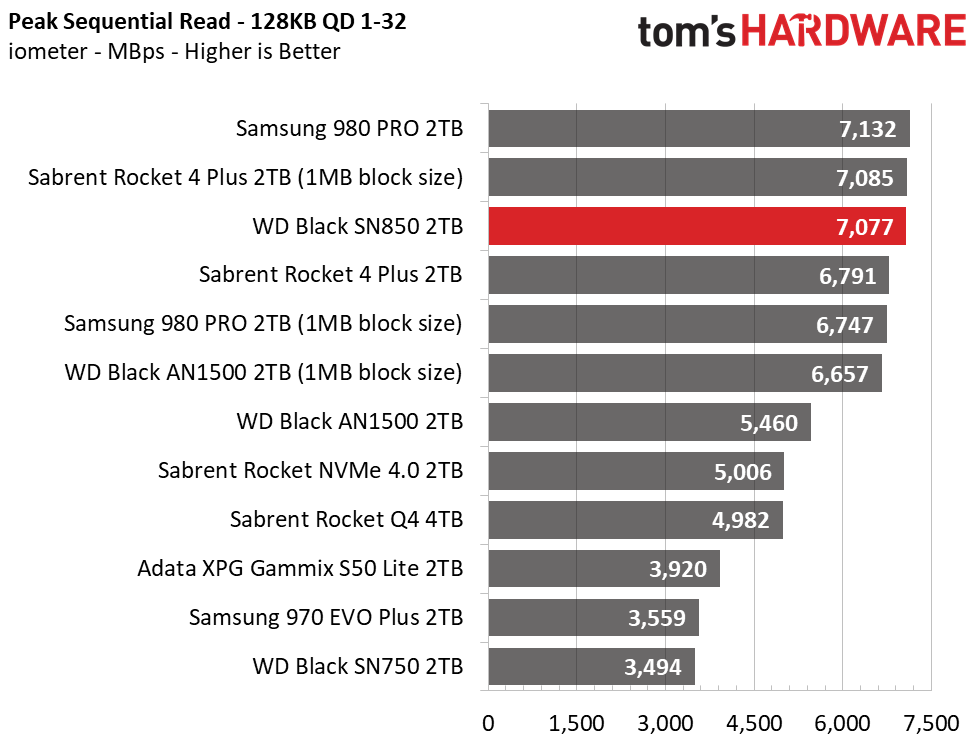
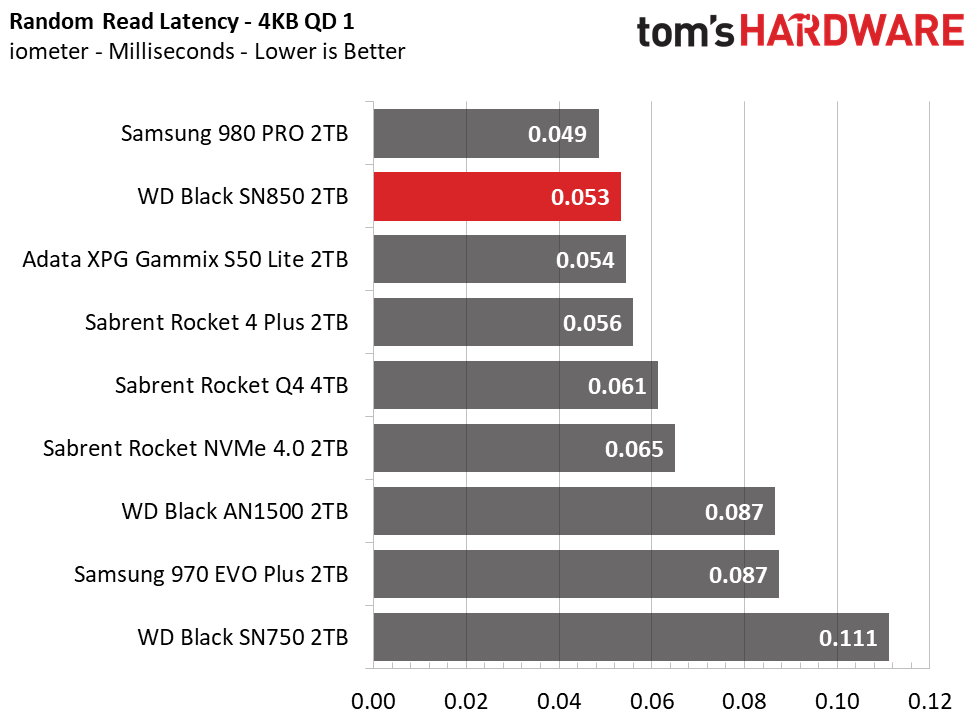


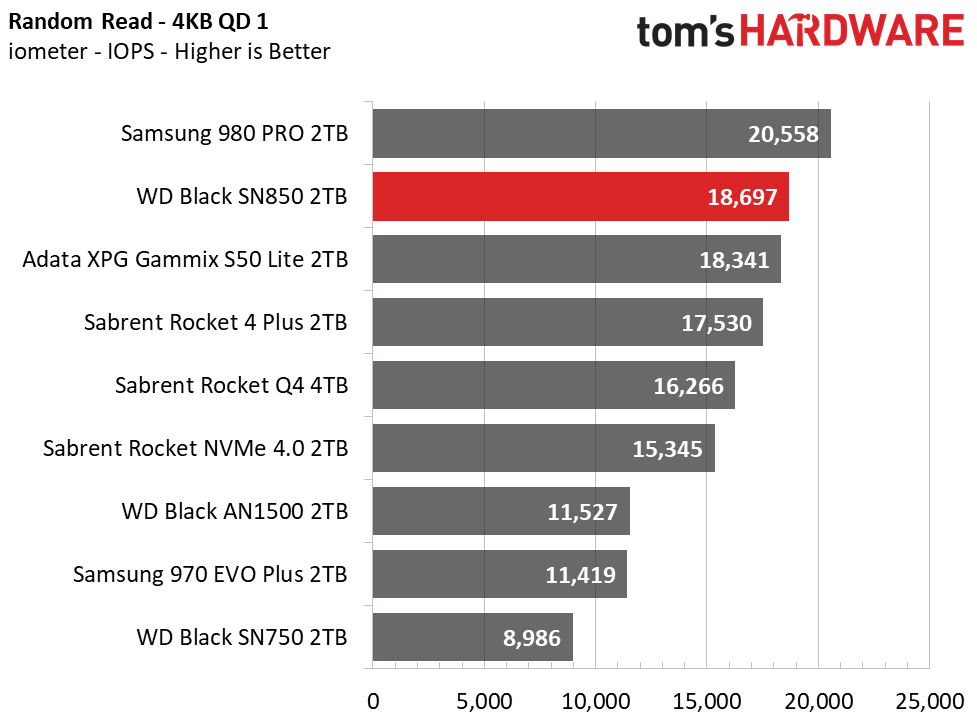
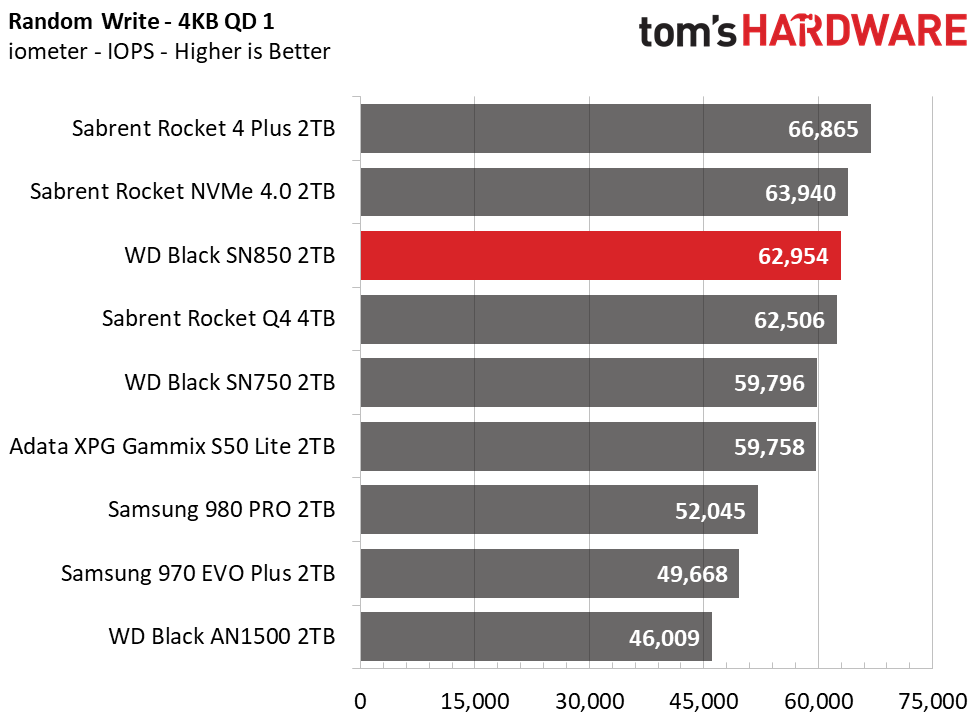


WD’s Black SN850 serves up fast sequential performance at a queue depth (QD) of 1, exceeding even the 980 Pro, but it runs into a small dip in performance when reading 512KB files.
The SN850’s peak performance matches the specs at 7.1 / 5.3 GBps of read/write throughput, and the drive serves up stellar performance in random workloads, too. At a queue depth (QD) of 1, the SN850 is almost as fast as the 980 Pro during the random read workload, and it even outperforms the 980 Pro by a large margin as the workload intensifies.
Sustained Write Performance and Cache Recovery
Official write specifications are only part of the performance picture. Most SSDs implement a write cache, a fast area of (usually) pseudo-SLC programmed flash that absorbs incoming data. Sustained write speeds can suffer tremendously once the workload spills outside of the cache and into the "native" TLC or QLC flash. We use iometer to hammer the SSD with sequential writes for 15 minutes to measure both the size of the write cache and performance after the cache is saturated. We also monitor cache recovery via multiple idle rounds.

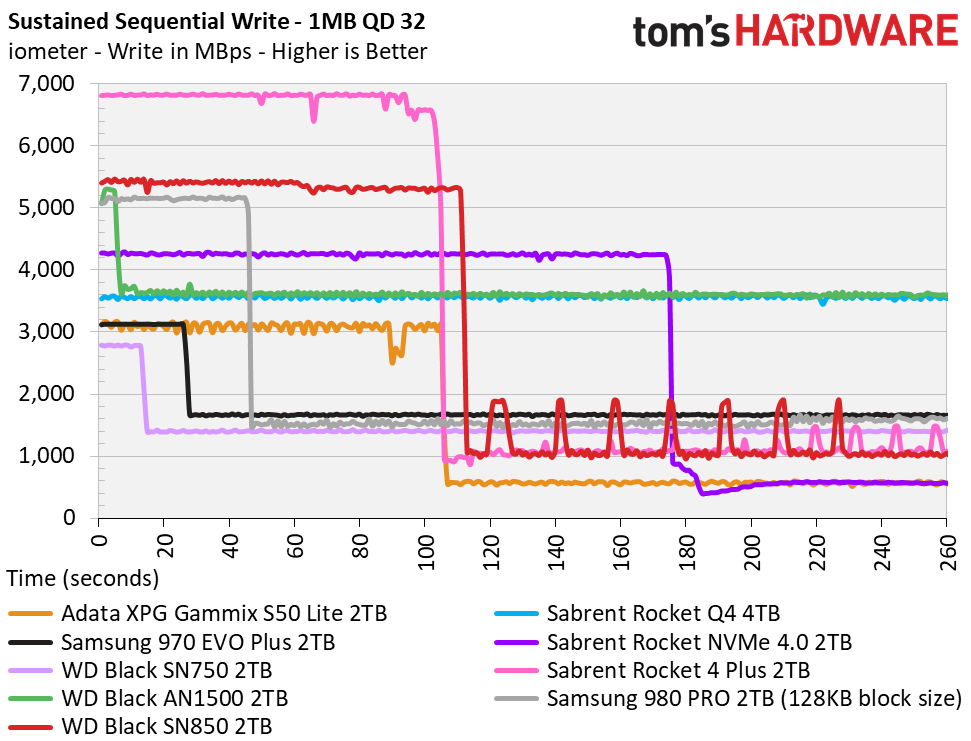
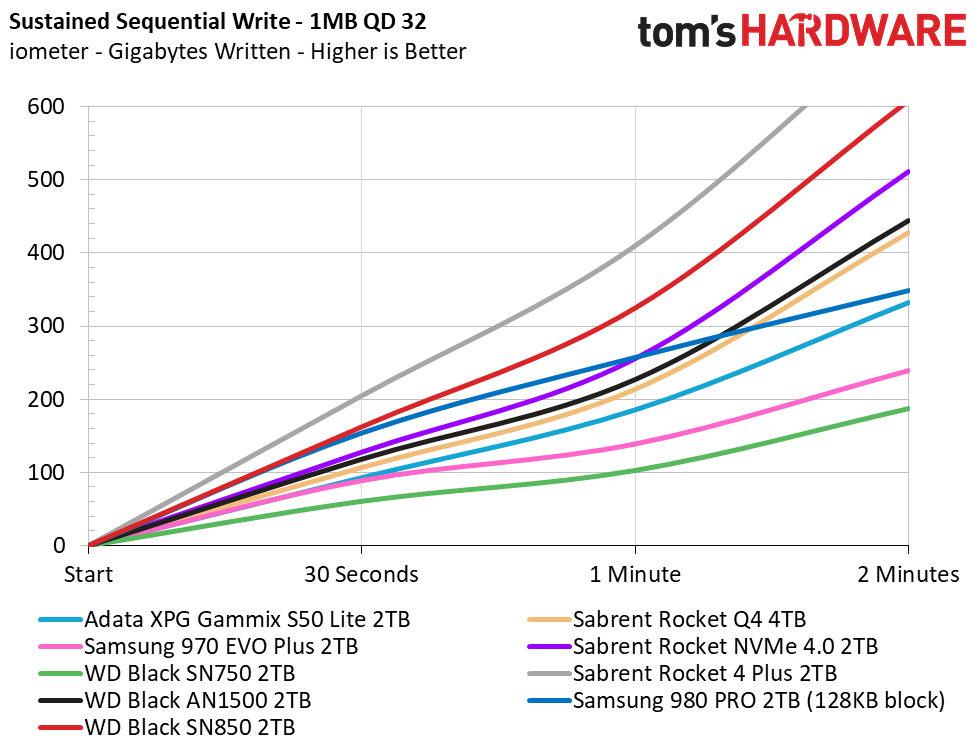
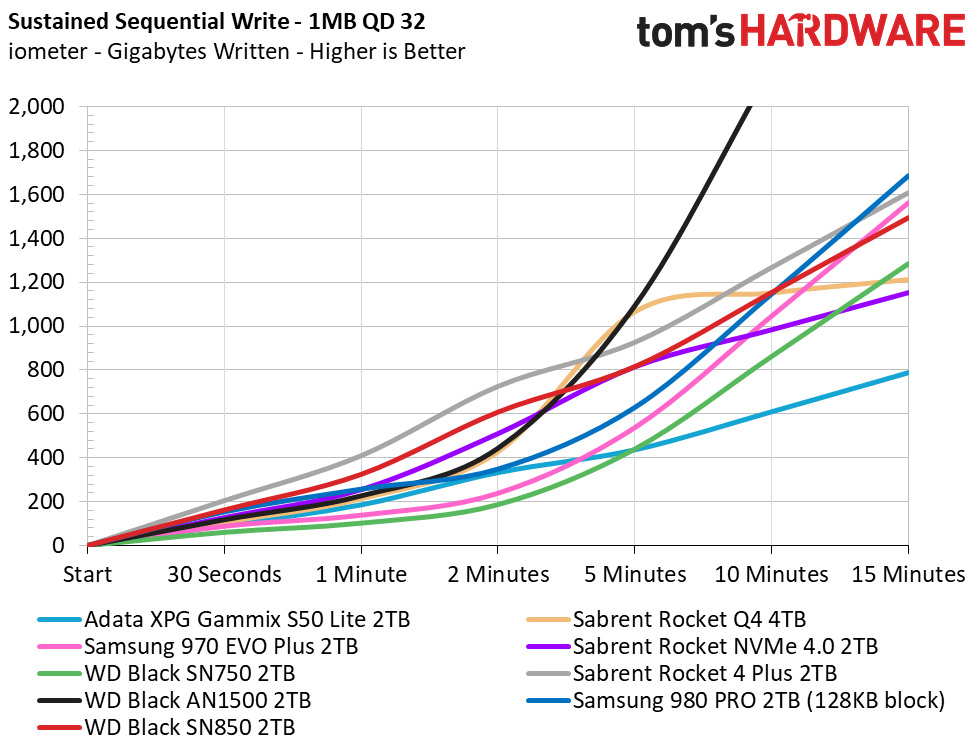
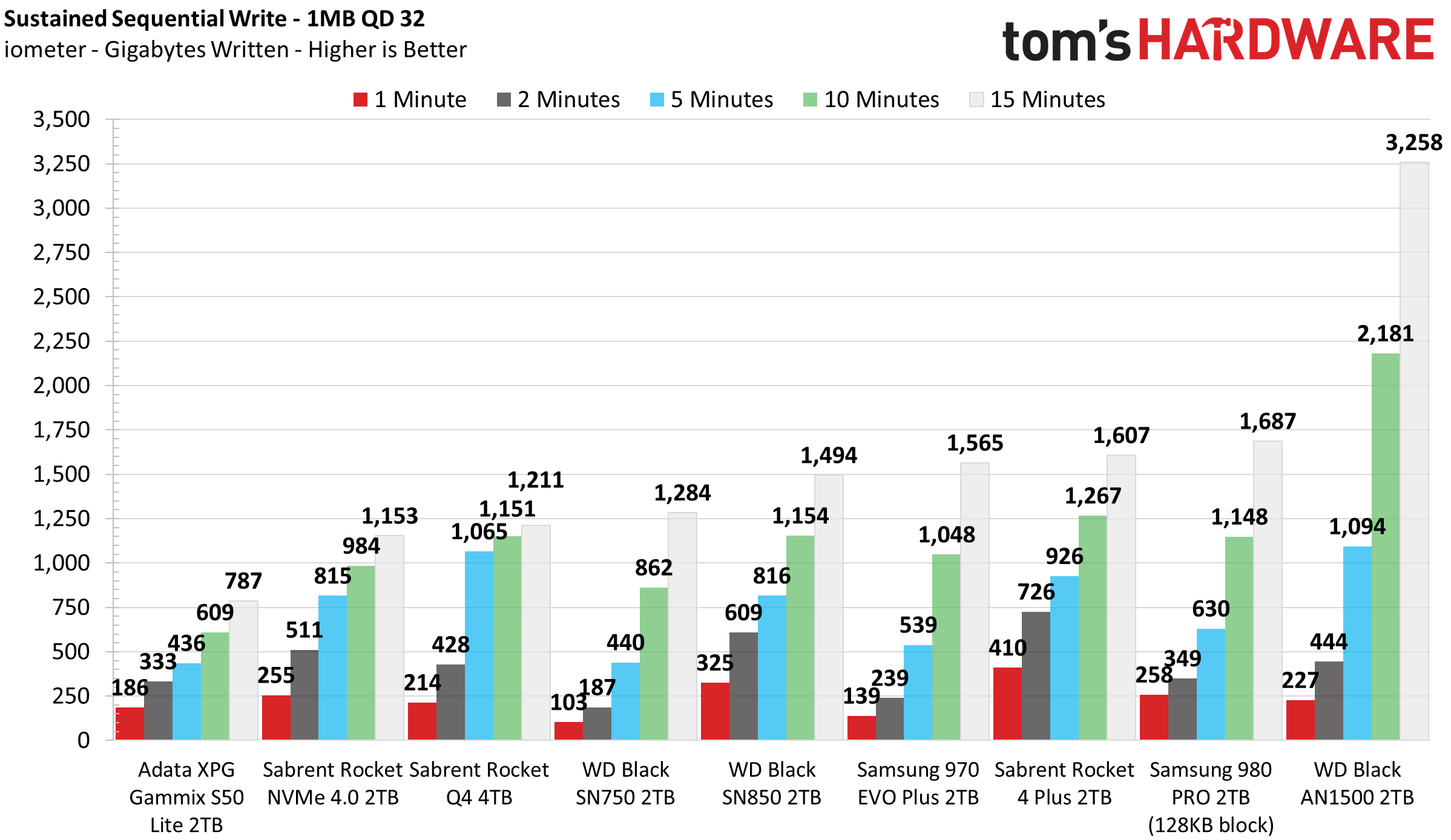
The SN850’s nCache 4.0 weighs in at 600GB for the 2TB model, making it my favorite SLC cache revision from the company yet. We largely credit the SN850’s win over the 980 Pro in PCMark 10 to the bulky nCache 4.0. While full-dynamic SLC cache designs may degrade to very slow sustained write speeds, as we see with the Sabrent Rocket 4 Plus, nCache 4.0 uses a hybrid approach similar to Samsung’s TurboWrite to mitigate that issue (at least to a greater extent).
While Samsung’s TurboWrite offers awesome sustained performance over the 980 Pro due to its more conservative capacity, it only ensures a 6GB static cache at the 1TB and 2TB capacities. In contrast, the SN850’s cache is larger and scales with drive capacity. In contrast, WD infuses its drive with 12GB of static SLC cache for the 1TB model, and doubles that to 24GB for the 2TB model.
This means that after the dynamic SLC caches are saturated (full), a larger portion of SLC flash remains. That extra cache helps the SSD respond more quickly to the small bursty workload requests that are a hallmark attribute of desktop operating systems. WD’s nCache 4.0 also recovers faster than the 980 Pro, recovering 70GB of capacity after only a minute of idle time. In contrast, even after idling for half an hour, only the static portion of the 980 Pro’s cache recovered.
Power Consumption and Temperature
We use the Quarch HD Programmable Power Module to gain a deeper understanding of power characteristics. Idle power consumption is an important aspect to consider, especially if you're looking for a laptop upgrade. Some SSDs can consume watts of power at idle, while better-suited ones sip just milliwatts. Average workload power consumption and max consumption are two other aspects of power consumption, but performance-per-watt is more important. A drive might consume more power during any given workload, but accomplishing a task faster allows the drive to drop into an idle state more quickly, ultimately saving energy.
We also monitor the drive’s temperature via the S.M.A.R.T. data and an IR thermometer to see when (or if) thermal throttling kicks in and how it impacts performance. Bear in mind that results will vary based on the workload and ambient air temperature.
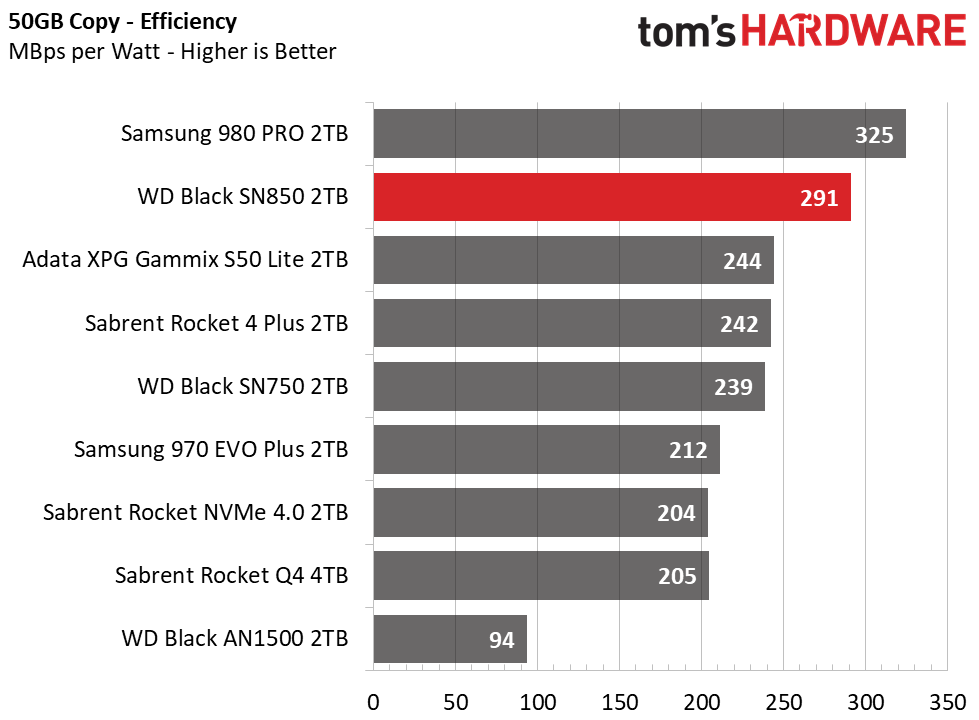
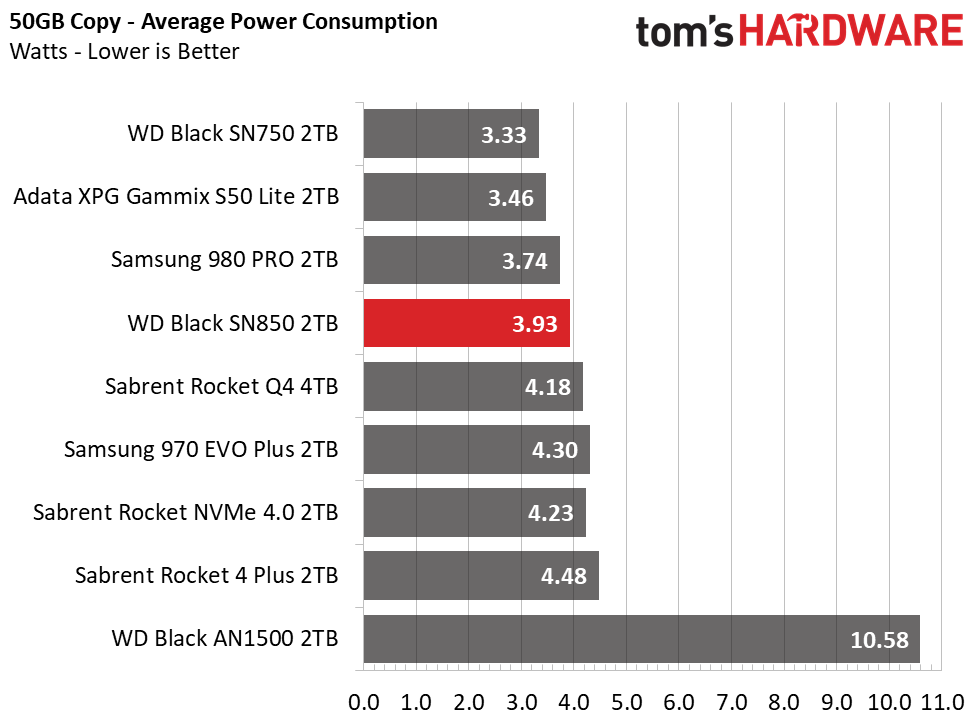


With very fast performance and solid power management, WD’s Black SN850 is a very efficient SSD under load. In notebook applications with ASPM enabled, the SN850 will scale down to very low power states and sip only a few mW of power. However, the Black SN850’s idle power consumption was very high in our desktop test bench, measuring twice that of Samsung’s 980 Pro, meaning it isn’t quite as efficient overall.
To test thermal management, we set the room to 23C and left the SSD without airflow in an open-air test bench. With ASPM disabled and the Windows power profile set to High Performance, the controller’s idle temperature was warm at roughly 55C on the surface (44C via S.M.A.R.T data), while the NAND was 10C-12C cooler when measured with an IR thermometer.
We observed peak temperatures of 92C (accurate with S.M.A.R.T reporting) after the SLC cache absorbed 700GB of data and read back roughly half of that. Thermal throttling engaged when the controller surpassed 88C, which occurred after transferring roughly 600GB of data.
MORE: Best SSDs
MORE: How We Test HDDs And SSDs
MORE: All SSD Content
Current page: 2TB Performance Results
Prev Page Features and Specifications Next Page 1TB Performance Results
Sean is a Contributing Editor at Tom’s Hardware US, covering storage hardware.
